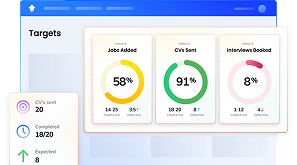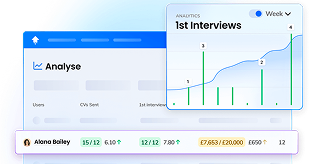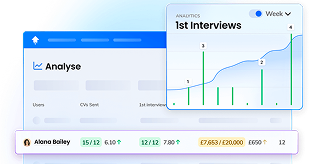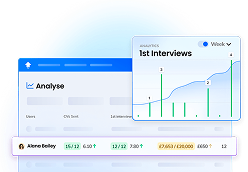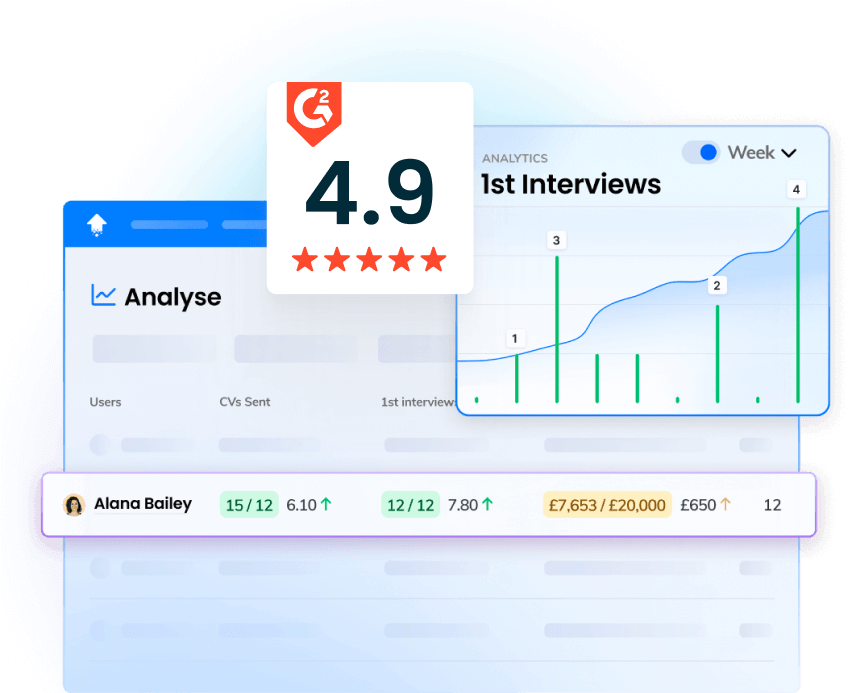Recruitment OKRs—Objectives and Key Results—are a framework for setting, tracking, and measuring goals within your recruitment agency.
Recruitment agencies employ OKRs to foster a culture of accountability and drive high performance.
In fact, getting your OKRs right can be the difference between growing a thriving recruitment agency with a vast portfolio of happy clients and leading a struggling agency with a questionable reputation.
In this guide, we'll explain why OKRs are vital for agencies and reveal how to craft, implement, and evaluate effective recruiting OKRs. We'll also provide some examples of effective recruiting OKRs to help you get started.
The Importance of OKRs in Recruitment
So why are OKRs for recruiting so crucial to overall agency success?
Enhancing Visibility and Accountability
Failing to clearly communicate your objectives with your recruiters at your agency will not deliver the results you want and need.
Employing OKRs gives you a framework that ensures the visibility of the goals as well as progress towards those goals.
For example, recruiters may be aware that your overall agency objective is to generate more revenue — but this does not exactly inspire accountability.
With no specific goal for either themselves or the team, individual recruiters are unable to take responsibility for directly generating a portion of that revenue through their recruitment activities.
Using an OKR, and then breaking this OKR down into smaller individual goals, tells them precisely how much revenue you expect them to generate — and by when.
In other words, it establishes clear expectations.
Using custom recruitment dashboards and leaderboards displayed on screens around the office, you can also ensure visibility of each recruiter's and team's progress towards these goals.

This way, each recruiter takes accountability for a certain percentage of the revenue you need to generate, which forces them to dive into the data and consider how they could bring in more money.
Aligning Recruitment Goals with Business Objectives
Using OKRs, you can align your recruitment team with overarching agency objectives, with every staff member working towards common goals.
OKRs can be harnessed to elevate the service you deliver to clients, improve your recruitment marketing strategy, create a positive work environment, and enhance recruiter engagement.
In fact, they can be used to measure almost any recruitment agency business objective.
This improves efficiency and effectiveness and ultimately gives your team the laser-sharp focus needed to achieve your business goals faster.
Here's an example.
One of your recruitment agency's business objectives for the year may be to work with larger client businesses.
Your agency's leaders may already be working hard towards this mission, but using an OKR framework makes your objective more tangible and measurable.
Your objective may be: 'Work with larger client businesses this year.'
But instead of leaving it there, the OKR framework prompts you to break this down into key results, such as: 'Bring on board [X number] of client businesses with headcount upwards of [Y number] by [Z date]'.
Not only will this give your agency leadership tangible figures to aim for, but it is now much easier to work out what every recruiter needs to do in order for them to contribute towards hitting this goal.
For instance, you could set each recruiter a SMART goal to make at least [X number] of business development calls to companies with a headcount of over [Y number] per week.
Progress towards your objective should be clearly and publicly tracked on a custom dashboard measuring each recruiter's contribution.
Custom dashboards can also be created for recruiters' individual SMART goals. You could even launch a competition where the first recruiter to hit their goal over a quarter receives an additional incentive.
This aligns recruitment goals with business objectives, ensuring everyone in the agency is pushing in the same direction.
Crafting Effective Recruiting OKRs
The importance of OKRs for recruitment cannot be understated — so how do you set about implementing this framework?
Setting Objectives
The first step is to set a clear, impactful, and tangible objective that will act as your agency's mission.
This objective may be based on your agency's values, designed to help your agency grow, or aimed at capitalising on your strengths or rectifying weaknesses.
For example, an agency that prides itself on delivering an outstanding candidate experience may set the general objective of:
'Improve the candidate experience'.
This is based around agency values, it capitalises on the agency's USP, and - done right — it should boost the business' reputation and help it to grow.
Defining Key Results
Now you've identified your objective, it's time to define your key results.
This means attaching quantifiable targets to your objective, enabling you to easily measure progress and results.
Each objective typically has between three and five key results attached to it.
Each key result should be a measurable metric that indicates whether your efforts to achieve your objective are successful.
These recruiting KPIs must be SMART.
This means:
- Specific
- Measurable
- Achievable
- Relevant
- Time-Bound
For instance, when considering the objective 'improve the candidate experience', you may choose the following key results.
- Increase overall candidate satisfaction score from surveys to [X number] by [Y date]
- Increase application completion rate to [X percentage] by [Y date]
- Ensure [X number] of touch points on every completed candidate journey by [Y date]
Before setting your key results, it's crucial to perform a benchmarking exercise to determine current recruitment benchmarks, consult your team to gather qualitative data, and ensure your targets are achievable.
Find out more about how to measure recruitment effectiveness here.
Examples of Effective Recruiting OKRs
Looking for some OKR examples for recruitment?
Here is what three common OKRs for recruiters might look like.
Objective 1: 'Boost Client Acquisition'
Bring in [X number] of new clients before [Y date]
Increase BD calls by [X percentage] by [Y date]
Boost conversion rate by [X percentage] by [Y date]
Objective 2: 'Increase Quality of Candidates'
Increase client satisfaction rate of hires by [X percentage] over [Y time period]
Increase average number of candidates invited to interview by [X percentage] over [Y time period]
Ensure [X percentage] of placements reach [Y date] milestone over [Z time period]
Objective 3: 'Reduce Time of Fill'
Decrease the time from 'vacancy added' to 'placement made' by [X percentage] by [Y date]
Reduce the time from 'vacancy added' to 'candidate sent' by [X percentage] by [Y date]
Increase pre-qualified candidate pool by [X percentage] by [Y date]
Implementing OKRs in Your Recruitment Team
You've decided on your OKRs for your recruitment agency — now it's time to implement them.
Here's how.
#1 Set Up Your Measurement Tools
Before rolling out your OKRs, you need to set up the vital infrastructure for tracking and measuring key results.
This means investing in a cutting-edge recruiting analytics software tool like OneUp.

When choosing your software, look for the following features:
- User-friendly interface: Your recruiters shouldn't need a data science qualification to understand it
- Custom dashboards: It's vital dashboards can be tailored to measure your specific key results
- Intuitive visualisations: You should be able to derive key insights at a glance
- Real-time data: There's little point making decisions based on old or irrelevant statistics
- Automation: This will save your team time on repetitive tasks
- Integrations: Ensure the software will slot seamlessly into your existing tech stack
- Motivational tools: The ability to create competitions and gamify tasks means you'll hit your goals faster

Once you've chosen your software, set up individual and team dashboards that measure progress towards your key results.
#2 Communicate Your OKRs to Your Recruitment Team
Now that your OKR infrastructure has been set up, it's time to roll out your OKRs to the agency.
Remember — your team’s buy-in is essential to your success.
Start with an agency-wide presentation in which you clearly communicate your objective and OKRs, and perform a demonstration of the custom dashboards your team will use to check their progress.
Give them solid instructions on how this will affect their day-to-day workflows, what they need to do, and when they need to do it.
Next, set up one-to-ones with all recruiters where you take them through their individual custom dashboards, and explain how their personal targets will feed into hitting the overall objective.
Build these individual targets into personal development plans, and ensure they know you're on hand to answer any and all questions surrounding the OKRs.
Finally, set up formal training sessions to ensure every team member is confident using your new software.
Monitoring and Evaluating OKRs
Once roll-out is complete, you can set upon the task of monitoring and evaluating your OKRs.
Tools and Techniques for Tracking Progress
Recruiting analytics software OneUp simplifies performance management, motivation, and reporting.

With real-time data, custom dashboards complete with beautiful visualisations, and a user-friendly interface, OneUp makes measuring OKRs easy.
Set up custom dashboards to track key results and drive accountability. Deep dive into performance data from all your systems in one place. Save time on reporting with automated emails of reports whenever you need them.
You can also motivate your recruitment teams by tapping into OneUp's gamification features, including leaderboards, leagues, missions, challenges, and personalised celebration anthems.
OneUp's features are super shareable. You can broadcast real-time leaderboards and targets across screens around your office, as well as email and live chat alerts and daily digests via email.
Adjusting OKRs Based on Performance Data
Before setting your OKRs, it's crucial to gather as much benchmarking data as possible to ensure your targets are realistic and that your key results feed into your objective.
Read our State of Recruitment report to discover key recruiting benchmarks in 2024.
However, your OKRs are never going to be perfect from the off.
Indeed, you should see them as living, breathing entities that are continuously evolving based on new performance data.
When your performance data is telling you something, don't ignore it! Instead, continuously adjust your OKRs to ensure success.
Let's look at the following OKR for recruiters: 'Boost Client Acquisition'. One of the key results here is 'Bring in [X number] of new clients before [Y date]'.
But what do you do if your performance data tells you that, just halfway through the allotted time period, your recruiters have already hit that goal?
Your first instinct may be to simply double the target — and that's not necessarily a bad idea.
But it's also vital to drill down into the data to determine how this was possible.
For example, perhaps recruiters have been targeting clients with low budgets or very small projects in order to boost the quantity of conversions.
Unfortunately, you're unlikely to see the revenue growth you were hoping for in this scenario.
To rectify this, you could adjust your key result to: 'Bring in [X number] of new clients with budgets of over [Y number] before [Z date]'.
Final Thoughts
The transformative potential of OKRs for recruitment agencies cannot be understated.
They give you and your team the purpose you need to drive sustained growth, improve team dynamics, and, of course, boost the bottom line.
Accurately measuring your key results is a crucial component of success when it comes to OKRs — and this means you need to invest in the very best recruitment analytics software for your team.
OneUp includes all the tools and features you need to ensure your OKRs result in recruitment success. Book a demo here today and hit your performance management objective.
